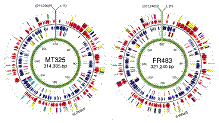Virology, Nebraska Center for
ORCID IDs
Document Type
Article
Date of this Version
10-1-2004
Abstract
A single tube, fluorogenic probe-based, real-time quantitative reverse transcription-polymerase chain reaction (Q-RT-PCR) assay was developed for detection and quantitation of bovine respiratory syncytial virus (BRSV) using BioRad’s iCycler iQ™. Real-time Q-RT-PCR was compared with quantitative competitive RT-PCR (QC-RT-PCR) and viral titers. Viral mRNA levels were measured in BRSV-infected bovine turbinate cell lysate harvested at eight time points (1.5, 6, 12, 24, 36, 48, 60, 72 h) post-infection. A homologous BRSV cRNA standard was used for quantitation of the mRNA by plotting a standard curve of cycle threshold (Ct) values versus standard 10-fold dilutions of cRNA of known concentrations. Detection as low as 171 copies/μl of standard BRSV cRNA was possible. For QC-RT-PCR, a competitor RNA molecule having a deletion was designed and used for quantitation of the BRSV viral mRNA. The results of real-time Q-RT-PCR and QC-RT-PCR assays showed a positive correlation. Real-time Q-RT-PCR was a sensitive, specific, rapid, and efficient method that eliminates the post-PCR processing steps when compared to QC-RT-PCR. Quantitation of BRSV using real-time Q-RT-PCR will have application in studies aimed at understanding the pathogenesis of BRSV.



Comments
Published in Journal of Virological Methods 121:1 (October 2004), pp. 1-6; doi 10.1016/j.jviromet.2004.05.004 Copyright © 2004 Elsevier B.V. Used by permission. http://www.sciencedirect.com/science/journal/01660934 A contribution of the University of Nebraska Agricultural Research Division, Lincoln, NE 68583, USA. Used by permission.